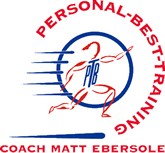
Chicago Marathon 2013



 |
| Overpeck, Lazzara, Sulewski |

Entry Fees | ||
Event | Pre-Registered | Race Day |
5 Mile | $22.00 | $25.00 |
5 Mile(Public Safety Personnel) | $18.00 | $20.00 |
5K | $22.00 | $25.00 |
5K(Public Safety Personnel) | $18.00 | $20.00 |




 Wasn't last night fun? OK, it was great to get the workout in and even better to be done. It was fantastic to have so many join in at the track for this workout.
Wasn't last night fun? OK, it was great to get the workout in and even better to be done. It was fantastic to have so many join in at the track for this workout. Tuesday night was our first post Mini, hot-humid workout of consequence. With some adaptation the conditions were not too bad but with the very slow developing spring/summer weather it had quite an effect. Because I received lots of questions after this workout ranging from what to do about HR drift in the heat to is it normal to feel so bad for the first runs in these conditions I thought it would make a good blog topic. Because I got good HR and pace information from my monitor I have listed my splits with average HR and a link to all the details you could ever want to see.
My splits (average heart rate) 5 mile steady state run at 75-85%
6:45 (144), 6:42 (156), 6:41 (159), 6:29 (163), 6:26 (168) 33:03
Course note: This is an out and back course slightly uphill out and downhill back.
Polar Personal Trainer details link
The prescribed workout effort of 75-85% should be comfortably hard. It should work into high end aerobic effort but never venture into the land of racing.
We know that with hot & humid conditions and the resulting dehydration the heart has to beat faster to deliver oxygen to compensate for blood volume loss. Going into the workout it was clear that HR was going to drift over the given zone, in my case 145-160.
The key in this situation is to let it go but make sure once north of the upper limit to relax and not continue to push. It is a good strategy for longer steady state runs, especially in warmer conditions, to try to stay in the bottom half of the zone for half of the run to be able to keep within the zone for the second half. Under ideal conditions you should be able to dial in to a heart rate and keep it there for this duration.
At about 2.5 to 3 miles this started to feel like work so I relaxed and tried to keep the HR down in the zone. Somewhere between 3 & 4 I exceeded the zone and just tried to maintain the perceived effort. As Neill began to pull away around 4 it was time to decide to stick with the workout or race. I chose to stick with the workout which was a brilliant idea because I might not have been able to keep up with Harrington had I chosen to race.
Overall, I was very pleased to see the progression of pace, even with the benefit of some downhill coming back and the HR, though over the zone, was controlled.
Yes, Mr. Kremer it is normal to feel that bad for the first few runs in these conditions. It is just a matter of remembering the workout objective and sticking to it. It does not always result in training log entries you are proud of but the work gets done and the running machine gets stronger.